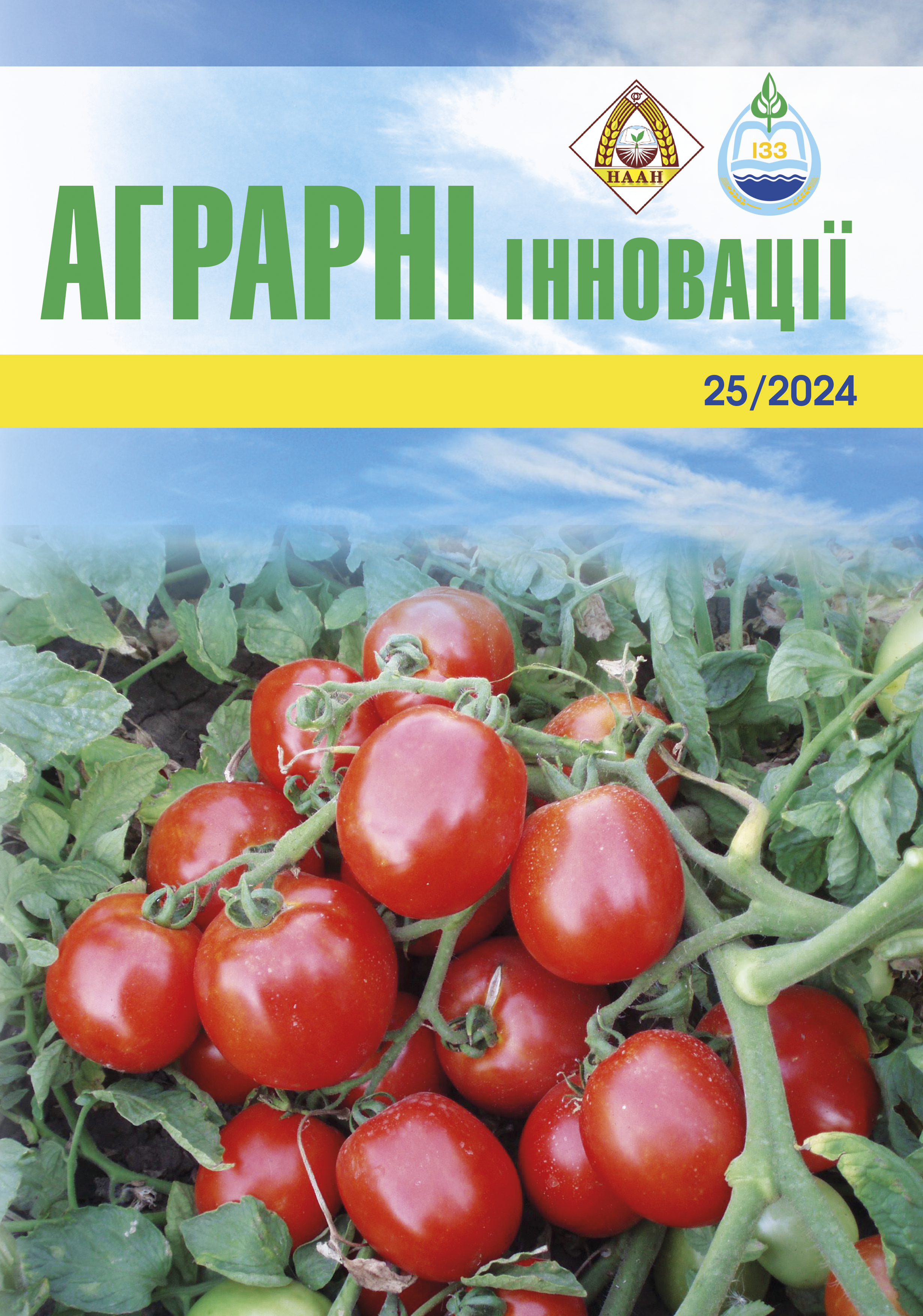Bugs (Hemiptera) on winter wheat in Forest-Steppe Ukraine
Abstract
The purpose. Clarifying the species composition of Hemiptera of the agrocenosis of winter wheat in the conditions of the forest-steppe of Ukraine, determining the dominantspecies of phytophages. Analysis of the state of populations, periods of harmfulness, conditions of increase in numbers and preparation of a forecast for the development of harmful organisms in the following years. Research methods and materials. The research was conducted in the Forest-Steppe of Ukraine during 2019–2023 on winterwheat crops that were planted in the Obukhivskyi (2023) and Bilotserkivskyi districts of the Kyiv region. Varieties of winter wheat were grown: Podolyanka, Horodnytsia, Sofia Kyivska, Bohdana, Ladyzhinka. The research was carried out according to the methods generally accepted in entomology: mowing with an entomological net, inspection of the accounting sites, collection from plants, theoretical (proposing a hypothesis and forming conclusions based on the results of research; statistical; mathematical. Theresults. In general, specialized bugs-pests of cereal crops (Austrian tortoiseshell (Eurygaster austriacus Schrck.), harmful tortoiseshell (Eurygaster integriceps Put.), Moorish tortoiseshell (Eurygaster maurus L.), nosed elm (Aelia rostrata Boh.) and sharp-headed elm (Aelia acuminata) L.) was found in 43.8% of the total. The rest of the hemioptera were found in small numbers, most of them are not specialized pests of grain crops and are of no economic importance. Their feeding mostly took place on segetal plants, which are always present in the agrocenoses of the wheat field. As for the population of wheat plants by varieties and phases of development, the advantages of any variety have not been found. Affects the generative organs (flowers, pistillate threads, forming grains) of all cereal crops. The orderof semi-hermoptera (Homoptera) in agrobiocenses of the wheat field is represented by 23 species. The dominant ones are the bread bug (Trigonotylus ruficornis Geoffr.), 22.3% of all discovered bugs belong to this species, 18.7% are the nosed elm (Aelia rostrata Boh.), 13% are the grass bug (Lygus rugilipennis Popp.), 0% and Moorish tortoise (Eurygaster maurus L.) – 12.8%. The rest of the bugs were not of economic importance, as they were found in small quantities. They fed on segetal plants. No difference was found in the settlement of bugs by varieties and phases of development of winter wheat plants. Conclusions. The dominant one is a broad polyphagous bug (Trigonotylus ruficornis Geoffr.). Among bread bugs (family Scutelleridae) in the phase of milk ripeness, wheat was damaged by older larvae of the Moorish beetle (Eurygaster maurus L.).According to the research results, no outbreaks of harmful species of bugs are expected in the Forest Steppe of Ukraine next year.
References
С. 71–89.
2. Білецький Є.М. Теорія і технологія багаторічного прогнозу. Інтегрований захист рослин на початку ХХІ століття: матер. Міжнар. наук.-практ. конф.
Київ, 2004. С. 29–36.
3. Мельничук М.Д., Григорюк І.П., Чайка В.М. Глобальні зміни клімату загроза біоресурсам України. Біоресурси планети: соціальні, біологічні, про-
довольчі та енергетичні проблеми. Київ, 2008. С. 42–57.
4. Козак Г.П. Шкідливий ентомокомплекс озимої пшниці в Лісостепу України в умовах змін клімату. Землеробство. Київ, 2005. Вип.77. С. 65–72.
5. Сушко Д.Ю., Волошина Н.О. Вплив змін клімату на стан популяції та розвиток комах. “VinSmartEco”: Збірник матеріалів IІ Міжнародної науково-практичної конференції, (м. Вінниця, 20–21 травня 2021). Вінниця: КЗВО “Вінницька академія безперервної світи”, 2021. С. 67–69.
6. Федоренко В.П., Чайка В.М., Бакланова О.В. та ін. Потепління і фітосанітарний стан агроценозів України. Карантин і захист рослин. 2008. № 5. С. 2–5.
7. Федоренко А. Домінантні шкідники зернових колосових культур з ряду твердокрилих та прогноз чисельності у 2024 р. Карантин і
захист рослин. 2024. № 1. С. 23–27. https://doi.org/10.36495/2312-0614.2024.1.23-27
8. Рудік О.Л. Адаптація виробництва зернових культур до глобальних змін клімату. Тенденції та перспективи розвитку менеджменту в умовах глобальних викликів: матеріали І Міжнар. науково-пр-акт. конф. (м. Херсон, 28 травня 2021 р.) Херсон,
2021. С. 175–178.
9. Жук О.І. Формування та продуктивність рослин пшниці озимої за несприятливих умов навколишнього середовища. Генетика і селекція в сучасному агро-
комплексі: матеріали Всеукраїнської науково-практ. конф. молодих вчених. Умань, 2021. С. 65–68.
10. Федоренко В.П. Наукові основи прогнозування поширення шкідників в агроценозах України. Пропозиція. 2022. № 1. С. 54–60.
11. Федоренко В.П. Покозій Й.Т., Круть М.В. Ентомологія / за ред. академ. В.П. Федоренка. Київ, 2013. 344 с.
12. Петренкова В., Ниска І. Основні шкідники колоса на зернових. Пропозиція. 2018. № 6. URL: https://propozitsiya.com/ua/osnovni-shkidniki-kolosa-nazernovih






